Halloween is a time of fun and excitement for kids, filled with costumes, treats, and spooky adventures. However, it’s also a night when orthopedic injuries can become all too common. From trips and falls to injuries from props and decorations, Halloween has its share of risks that can lead to fractures, sprains, and other injuries in children. As an orthopedic surgeon, here are some key ways to ensure a safe and injury-free Halloween, along with tips to avoid the most common pediatric injuries.
Common Pediatric Injuries on Halloween
Halloween night can present a range of risks for children as they navigate dark streets and maneuver in costumes. Some of the most common injuries seen in orthopedic practices around Halloween include:
- Fractures and Sprains from Falls: Children often trip over costumes, sidewalks, or unseen obstacles in the dark, leading to wrist, ankle, or even collarbone fractures and sprains.
- Cuts and Puncture Wounds from Props: Halloween costumes frequently involve accessories like swords, wands, and sharp or hard-edged props. These can cause puncture wounds, cuts, or even sprains if not handled carefully.
- Head and Shoulder Injuries: Excited kids running between houses or playing in the dark may collide with each other or obstacles, leading to head, shoulder, or arm injuries.
- Foot and Ankle Injuries from Poor Footwear: Costumes can call for unconventional shoes or even high heels, which can cause ankle sprains or foot pain as children walk longer distances while trick-or-treating.
Preventing Halloween Injuries: Tips for Parents and Kids
There are plenty of precautions that can reduce the risk of orthopedic injuries while still allowing kids to enjoy their Halloween adventure. Here are some simple safety tips to keep in mind:
1. Costume Safety: Choose Comfortable, Well-Fitting Costumes
- Avoid Tripping Hazards: Costumes should be the right length to prevent tripping. Avoid capes, long gowns, or loose pieces that can catch on obstacles.
- Skip Restrictive Masks: Masks with limited visibility can cause kids to miss obstacles in their path. If a mask is essential, make sure it has large eye openings and allows them to see clearly.
- Choose Flexible, Lightweight Props: Opt for soft, flexible costume props to prevent injury if a child accidentally falls or bumps into something.
2. Safe Footwear: Wear Supportive Shoes
- Encourage children to wear closed-toe, supportive shoes, ideally something they’re comfortable walking in for long distances. Sneakers are a much safer choice than costume shoes, as they provide better stability and help prevent slips.
3. Visibility Matters: Add Lights and Reflective Elements
- Add Reflective Tape or Glow Sticks: Attaching reflective tape or giving kids glow sticks will make them more visible to drivers and other pedestrians.
- Carry Flashlights: Flashlights help kids see where they’re walking, especially if sidewalks are uneven or if they encounter unexpected obstacles like garden decorations.
4. Street Safety: Remind Kids to Walk, Not Run
- Set Ground Rules: Excitement often leads kids to run from house to house, increasing the risk of tripping or colliding with obstacles. Encourage kids to walk instead of running, especially on dark or unfamiliar paths.
- Cross Streets Safely: Teach children to look both ways before crossing streets and to use crosswalks whenever possible.
5. Group Safety: Trick-or-Treat in Supervised Groups
- Supervise Younger Children: Children under 12 should have adult supervision while trick-or-treating to ensure they stay safe and follow safety guidelines.
- Keep Older Kids in Groups: If older kids go out alone, encourage them to stick together, as group trick-or-treating reduces the likelihood of injuries and allows them to watch out for each other.
6. Check for Hazards Around the Home: Prep Your Own Yard
- Remove tripping hazards like hoses, garden equipment, or decorations that could be hidden in the dark. Create a clear path to your door for trick-or-treaters to reduce the chances of accidents on your property.
What to Do if an Injury Occurs
Even with precautions, injuries can happen. Knowing how to respond can make a big difference:
- Sprains and Strains: If a child sprains their ankle or twists a wrist, apply the R.I.C.E. method: Rest, Ice, Compression, and Elevation. Seek medical attention if pain or swelling persists.
- Fractures: If you suspect a fracture (such as a visible deformity, swelling, or inability to bear weight), immobilize the area and seek immediate medical care.
- Minor Cuts and Punctures: Clean the wound with warm water and apply a bandage. If the injury is deep or continues to bleed, see a doctor for possible stitches or further care.
Final Thoughts: Keeping Halloween Fun and Safe
By making a few adjustments to costumes, footwear, and safety practices, Halloween can be both fun and injury-free for kids. Simple steps like ensuring costumes fit well, choosing supportive shoes, and adding visibility tools like flashlights go a long way in preventing common orthopedic injuries. As parents, supervising younger children and reminding older ones of safety practices helps make Halloween a safe adventure.
This Halloween, let’s focus on staying safe so kids can enjoy the treats—and avoid the tricks of unexpected injuries!
